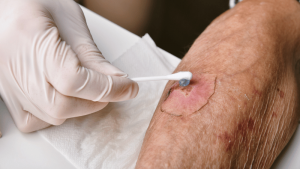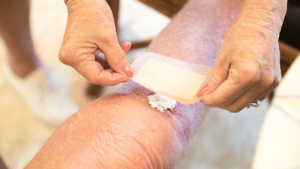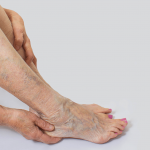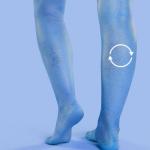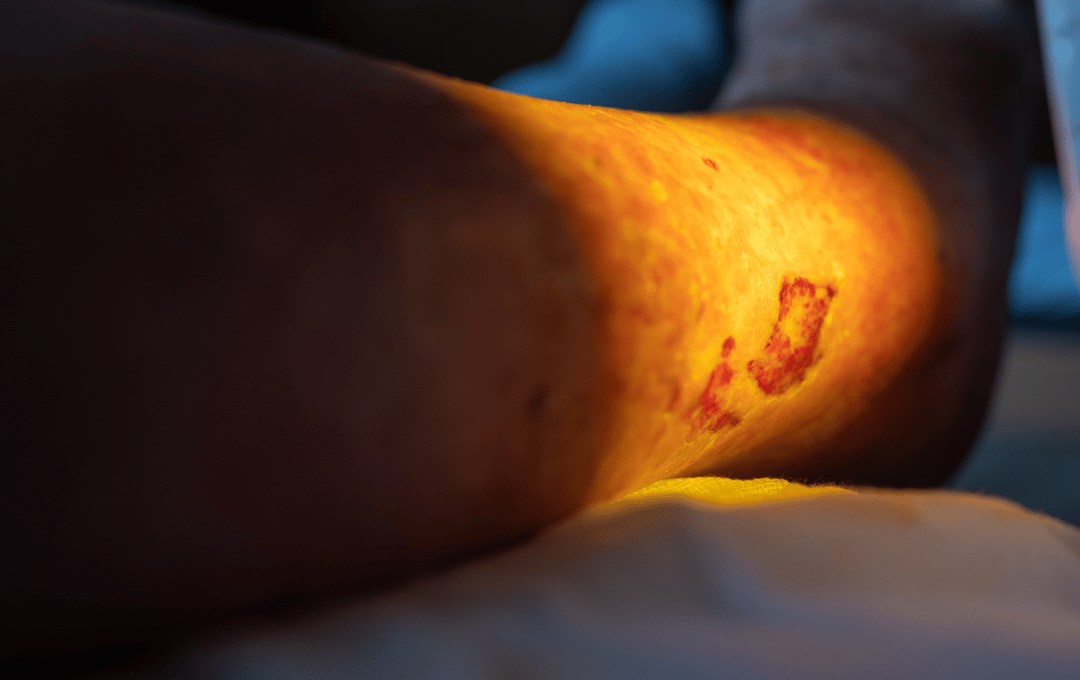
It often starts with what seems like a harmless sore – perhaps a patch of irritated skin or a small scrape on your foot or lower leg that hasn’t healed. Because it’s not painful, it’s easy to ignore. Days turn into weeks, and the sore remains. For many, this is the beginning of a venous leg ulcer, or a diabetic foot ulcer- both types of chronic wounds that can worsen due to poor circulation caused by damaged veins.
Without proper care, an untreated leg ulcer can grow larger, become infected, and cause significant tissue damage. In severe cases, chronic, infected, or diabetic leg ulcers can result in irreversible tissue damage, leading to amputation. Recognizing the warning signs of an infected ulcer and seeking early treatment protects your long-term health, mobility, and quality of life.
Can an Untreated Leg Ulcer Lead to Amputation?
Untreated leg ulcers may become deeply infected, leading to complications such as gangrene, bone infections (osteomyelitis), and sepsis, which can all lead to amputation. Leg ulcers can also lead to significant tissue damage, scarring, and limb dysfunction. Prompt intervention is essential for maintaining your health.
How Leg Ulcers Lead to Leg Amputation
Leg ulcers may start as minor wounds, but when they don’t heal properly or become infected, they can lead to complications that threaten circulation, mobility, and overall health, which can lead to tissue death.
Infected Leg Ulcers
Open wounds are vulnerable to bacterial infection. An untreated leg infection can escalate to the need for amputation.
Common warning signs of an infected leg ulcer include:
- Increasing pain
- Redness and swelling around the ulcer
- Warmth around the wound
- Pus or foul-smelling discharge
- Fever
If the infection penetrates deeper tissues or reaches the bone, it can cause severe damage, potentially requiring amputation to save the patient’s life.
Poor Circulation & Delayed Healing
Blood is helpful in healing wounds. When circulation is limited due to certain conditions, the body struggles to supply the nutrients and oxygen needed for healing. As a result, an untreated leg ulcer may remain open for months, increasing the risk of infection.
Underlying Health Conditions That Increase Amputation Risk
Certain medical conditions can make it more difficult for leg ulcers to heal properly, significantly raising the risk of infection or even leg ulcer amputation.
Health conditions and diseases that may contribute to limb loss include:
- Diabetes
- Peripheral artery disease (PAD)
- Chronic venous insufficiency (CVI)
- Lymphedema
- A medical history of blood clots or
These conditions impair circulation and slow tissue repair, making early detection and proper treatment especially important.
Types of Leg Ulcers and Their Risk of Amputation
Chronic leg ulcers come in several forms, and understanding the type of ulcer is key to choosing the proper treatment.
Diabetic Ulcers
Usually found on the feet or toes, diabetic ulcers result from nerve damage and poor circulation. Due to the body’s reduced ability to heal, this type of foot ulcer is at high risk of infection and amputation.
Arterial Ulcers
Peripheral artery disease (PAD) can cause ulcers, often on areas of pressure, such as the heels and toes. Arterial ulcers tend to be dry, painful, and look “punched out” compared to venous ulcers. They carry a high risk of complications and often require medical intervention.
Venous Ulcers (Venous Stasis Ulcers)
Venous ulcers are one of the most common types of chronic leg ulcers, but they are often overlooked. They develop due to chronic venous insufficiency (CVI), where weakened valves in the leg veins cause blood to pool, creating the appearance of varicose and spider veins. These ulcers appear near the ankles as red, shallow, moist wounds and can persist for months or even years without proper vein treatment. Over time, untreated venous ulcers increase the risk of infection and amputation.
Can Venous Ulcers Lead to Amputation?
While venous leg ulcers are less likely to lead to amputation than diabetic or arterial ulcers, the risk still exists, particularly when they become infected and worsen over time. Complications such as chronic infections, cellulitis, and delayed wound healing due to untreated chronic venous insufficiency (CVI) can all contribute to irreversible tissue damage.
Preventing these outcomes requires more than treating the surface wound. Addressing the underlying vein disease, such as varicose veins that contribute to the formation of leg ulcers, is essential for promoting healing and lowering the risk of leg ulcer amputation.
Learn More About What Leg Ulcers Look Like
Warning Signs a Leg Ulcer May Be Worsening
There are a few early warning signs that can indicate a worsening leg ulcer, such as:
- Sudden increase in pain
- Red streaks near the wound
- Fever or chills (possible infection)
- Black or discolored skin near ulcer edges
- The ulcer gets larger or deeper instead of healing
These symptoms should be taken seriously because the leg or foot ulcer may be infected. If you are experiencing these symptoms, head to the emergency room to be evaluated by a medical professional as soon as possible.
Leg Ulcer Prevention Strategies
Taking proactive steps can also help prevent a leg or foot ulcer from forming and progressing to a leg ulcer amputation. Here are some of the ways to prevent venous leg ulcers:
- Wear Compression Stockings: Compression therapy promotes blood flow and helps prevent leg ulcers from forming.
- Elevate Legs Daily: Raising your legs above heart level improves circulation and reduces fluid buildup.
- Avoid Prolonged Sitting or Standing: Moving frequently throughout the day supports healthy blood flow.
- Wound Care and Treatment: If you developed a leg ulcer due to vein disease, make sure the wound is kept clean and bandaged before seeking help from a vein specialist.
- Treat Varicose Veins Early: Addressing these conditions before they develop into ulcers can prevent serious complications.
Following these strategies significantly reduces your risk of developing a leg or foot ulcer. Staying proactive about your vein health through early diagnosis and treatment can also improve your long-term health and mobility.
How USA Vein Clinics Helps Prevent Leg Ulcers and Amputation
Most leg ulcers don’t have to end in amputation, especially when treated early. USA Vein Clinics offers several non-surgical treatment options to improve circulation and help ulcers heal faster:
- Endovenous Laser Treatment (EVLT)
- ClariVein® Treatment
- Varithena Vein Treatment
- VenaSeal™ Treatment
- Radiofrequency Ablation (RFA) Treatment
- Ultrasound-Guided Sclerotherapy
- Visual Sclerotherapy
Our specialists provide comprehensive evaluations and treatments to address the underlying cause of your symptoms. With the right approach, we can help reduce the risk of leg ulcer amputation and other serious complications from venous insufficiency.
FAQs
How Long Does it Take for a Venous Ulcer to Heal?
Venous ulcers can take up to six months to heal, but some ulcers may not resolve at all. Recommended treatments may include wound care, compression socks, or a minimally invasive procedure, such as Endovenous Laser Treatment (EVLT).
Can I Treat an Infected Leg Ulcer at Home?
It’s recommended to seek help from a medical professional before treating an infected leg ulcer at home. A medical professional can diagnose your condition and recommend an effective treatment plan to heal the ulcer.
How do I Know if I Have an Infected Leg Ulcer?
Signs of a leg ulcer may be infected include increasing pain, green or foul-smelling discharge, worsening redness, swelling, and fever. While some discharge and mild inflammation are expected during the healing process, any significant changes in these symptoms could signal an infection and should be evaluated by a doctor.
How do Doctors Determine if a Leg or Foot Ulcer Requires Amputation?
Doctors determine whether amputation is necessary for an infected leg ulcer by evaluating the extent of tissue damage, the severity of infection, and your overall health. Amputation may be required if the ulcer causes significant tissue loss or severe infection, but doctors typically explore other options before making this decision.

